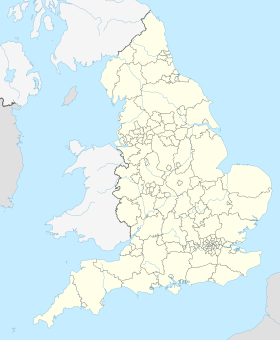Église Saint-Alfège de Greenwich

Pour les articles homonymes, voir Église Saint-Alphège.
| Église Saint-Alfège de Greenwich | ||
 | ||
| Présentation | ||
|---|---|---|
| Nom local | St Alfege Church | |
| Culte | Anglicanisme | |
| Début de la construction | 1712 | |
| Fin des travaux | 1714 | |
| Architecte | Nicholas Hawksmoor | |
| Style dominant | Architecture baroque | |
| Protection | Grade I | |
| Site web | http://www.st-alfege.org/ | |
| Géographie | ||
| Pays |  Royaume-Uni Royaume-Uni | |
| Nation constitutive |  Angleterre Angleterre | |
| Ville | Greenwich, Londres | |
| Coordonnées | 51° 28′ 49,7″ nord, 0° 00′ 34,8″ ouest | |
| Géolocalisation sur la carte : Angleterre
| ||
modifier  | ||
L'église Saint-Alfège (anglais : St Alfege Church) est une église située au centre de la ville de Greenwich, dans le district du même nom. D'origine médiévale, l'église est reconstruite de 1712 à 1714 sur un plan de Nicholas Hawksmoor.
L'église d'origine
Dédiée à saint Alfège (ou Alphège), elle est édifiée à l'endroit où cet archevêque de Cantorbéry est tué par les Vikings, le . La seconde église est construite au même endroit vers 1290. C'est là qu'Henri VIII est baptisé en 1491. L'ancienne église médiévale dont les fondations sont affaiblies par les enterrements successifs aussi bien à l'intérieur qu'à l'extérieur, s'effondre au cours d'une tempête en 1710,

Texte anglais à traduire :
The present church
Its replacement was built with a grant from the Commission for Building Fifty New Churches, to the designs of Nicholas Hawksmoor, one of the commission's two surveyors. The first church to be built by the commissioners, it was begun in 1712, and basic construction was completed in 1714[1]; it was not, however, consecrated until 1718[2].
The church is rectangular in plan with a flat ceiling, and a small apse serving as a chancel. At the east end, towards the street, is a portico in the Tuscan order. A central arch cuts through the entablature and pediment - a motif used in Wren's "Great Model" for St Paul's Cathedral[2]. A giant order of pilasters runs around the rest of the church: a feature Kerry Downes suggests may have been added by Thomas Archer, who, according to the minutes of the commission, "improved" Hawksmoor's plans[1]. To the north and south are wide projecting vestibules the full height of the church, with steps leading up to the doors[2].
Hawksmoor planned a west tower, in the position of the existing one. However the commission were reluctant to fund it, and the medieval tower was retained. In 1730 John James refaced it, and added a spire. Hawksmoor's design, published in an engraving in 1714 had an octagonal lantern at the top, a motif he was later to use at St George-in-the-East[1].
During the Blitz on 19 March 1941, incendiary bombs landed on the roof causing it to collapse, burning into the nave. The walls and the tower remained standing, but much of the interior was gutted. The church was restored by Sir Albert Richardson in 1953.
The Church is currently used to celebrate 'Founder's Day' of Addey and Stanhope School and The John Roan School.
Enterrements célèbres
Plusieurs personnalités ont été enterrées à Saint-Alfège, à l'intérieur ou aux alentours de l'église.
- Thomas Tallis, mort en 1585, compositeur et organiste de la Renaissance
- James Wolfe, mort en 1759, général britannique
- Henry Kelsey mort en 1724, explorateur du Canada.
- Lavinia Fenton, morte en 1760, actrice[3].
- John Julius Angerstein (mort en 1823), homme d'affaires, courtier de Lloyds et collectionneur d'art a été marguillier de l'église au début du XIXe siècle et y est également enterré


Littérature
Dans le roman de Charles Dickens L'Ami commun, Bella Wilfer épouse John Rokesmith dans l'église Saint-Alfège
Références
- (en) Cet article est partiellement ou en totalité issu de l’article de Wikipédia en anglais intitulé « St Alfege Church, Greenwich » (voir la liste des auteurs).
- ↑ a b et c (en) Kerry Downes, Hawksmoor, Londres, Thames and Hudson, coll. « World of Art », (1re éd. first published 1970), 110-11 p.
- ↑ a b et c (en) Bridget Cherry et Nikolaus Pevsner, London 2 : South, Londres, Penguin Books, coll. « The Buildings of England », (1re éd. 1983)
- ↑ 'Greenwich: The parish church', Old and New London: Volume 6 (1878), p. 190-205 accessed: 26 May 2007
Article connexe
Liens externes
Sur les autres projets Wikimedia :
- Église Saint-Alfège de Greenwich, sur Wikimedia Commons
- Site officiel

- Ressources relatives à l'architecture
 :
: - National Heritage List for England
- Structurae
- (en) Mystery Worshipper Report sur le site anglophone Ship of Fools
 Portail de l’architecture chrétienne
Portail de l’architecture chrétienne  Portail de Londres
Portail de Londres  Portail du protestantisme
Portail du protestantisme Portail de l'anglicanisme



















